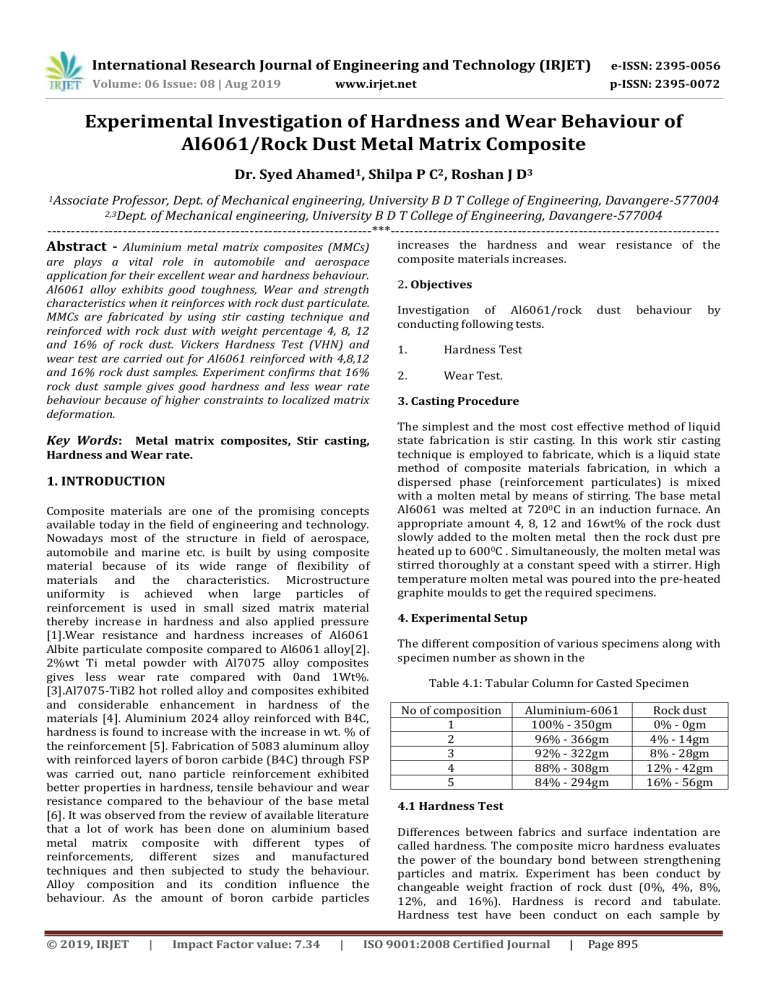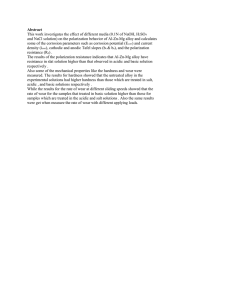IRJET- Experimental Investigation of Hardness and Wear Behaviour of Al6061/Rock Dust Metal Matrix Composite
advertisement

International Research Journal of Engineering and Technology (IRJET) e-ISSN: 2395-0056 Volume: 06 Issue: 08 | Aug 2019 p-ISSN: 2395-0072 www.irjet.net Experimental Investigation of Hardness and Wear Behaviour of Al6061/Rock Dust Metal Matrix Composite Dr. Syed Ahamed1, Shilpa P C2, Roshan J D3 1Associate Professor, Dept. of Mechanical engineering, University B D T College of Engineering, Davangere-577004 of Mechanical engineering, University B D T College of Engineering, Davangere-577004 ---------------------------------------------------------------------***---------------------------------------------------------------------2,3Dept. Abstract - Aluminium metal matrix composites (MMCs) are plays a vital role in automobile and aerospace application for their excellent wear and hardness behaviour. Al6061 alloy exhibits good toughness, Wear and strength characteristics when it reinforces with rock dust particulate. MMCs are fabricated by using stir casting technique and reinforced with rock dust with weight percentage 4, 8, 12 and 16% of rock dust. Vickers Hardness Test (VHN) and wear test are carried out for Al6061 reinforced with 4,8,12 and 16% rock dust samples. Experiment confirms that 16% rock dust sample gives good hardness and less wear rate behaviour because of higher constraints to localized matrix deformation. Key Words: Metal matrix composites, Stir casting, Hardness and Wear rate. 1. INTRODUCTION Composite materials are one of the promising concepts available today in the field of engineering and technology. Nowadays most of the structure in field of aerospace, automobile and marine etc. is built by using composite material because of its wide range of flexibility of materials and the characteristics. Microstructure uniformity is achieved when large particles of reinforcement is used in small sized matrix material thereby increase in hardness and also applied pressure [1].Wear resistance and hardness increases of Al6061 Albite particulate composite compared to Al6061 alloy[2]. 2%wt Ti metal powder with Al7075 alloy composites gives less wear rate compared with 0and 1Wt%. [3].Al7075-TiB2 hot rolled alloy and composites exhibited and considerable enhancement in hardness of the materials [4]. Aluminium 2024 alloy reinforced with B4C, hardness is found to increase with the increase in wt. % of the reinforcement [5]. Fabrication of 5083 aluminum alloy with reinforced layers of boron carbide (B4C) through FSP was carried out, nano particle reinforcement exhibited better properties in hardness, tensile behaviour and wear resistance compared to the behaviour of the base metal [6]. It was observed from the review of available literature that a lot of work has been done on aluminium based metal matrix composite with different types of reinforcements, different sizes and manufactured techniques and then subjected to study the behaviour. Alloy composition and its condition influence the behaviour. As the amount of boron carbide particles © 2019, IRJET | Impact Factor value: 7.34 | increases the hardness and wear resistance of the composite materials increases. 2. Objectives Investigation of Al6061/rock conducting following tests. 1. Hardness Test 2. Wear Test. dust behaviour by 3. Casting Procedure The simplest and the most cost effective method of liquid state fabrication is stir casting. In this work stir casting technique is employed to fabricate, which is a liquid state method of composite materials fabrication, in which a dispersed phase (reinforcement particulates) is mixed with a molten metal by means of stirring. The base metal Al6061 was melted at 7200C in an induction furnace. An appropriate amount 4, 8, 12 and 16wt% of the rock dust slowly added to the molten metal then the rock dust pre heated up to 6000C . Simultaneously, the molten metal was stirred thoroughly at a constant speed with a stirrer. High temperature molten metal was poured into the pre-heated graphite moulds to get the required specimens. 4. Experimental Setup The different composition of various specimens along with specimen number as shown in the Table 4.1: Tabular Column for Casted Specimen No of composition 1 2 3 4 5 Aluminium-6061 100% - 350gm 96% - 366gm 92% - 322gm 88% - 308gm 84% - 294gm Rock dust 0% - 0gm 4% - 14gm 8% - 28gm 12% - 42gm 16% - 56gm 4.1 Hardness Test Differences between fabrics and surface indentation are called hardness. The composite micro hardness evaluates the power of the boundary bond between strengthening particles and matrix. Experiment has been conduct by changeable weight fraction of rock dust (0%, 4%, 8%, 12%, and 16%). Hardness is record and tabulate. Hardness test have been conduct on each sample by ISO 9001:2008 Certified Journal | Page 895 International Research Journal of Engineering and Technology (IRJET) e-ISSN: 2395-0056 Volume: 06 Issue: 08 | Aug 2019 p-ISSN: 2395-0072 www.irjet.net means of a load of 5 kgf and Pyramidal Diamond indenter whose faces are set at a 136 degree angle from one another. Dimension of impression prepared by indenter have been predict by microscope. The equivalent value of hardness (VH) was calculated from standard formula. Place the specimen on the anvil so that its surface will be normal to the direction of the applied load. Note the type and size of the indenter. Adjust the weights on the plunger according to the type of the test whether it is Rockwell shown in charts by load selection disc. Keep the lever the position at A. Raise the anvil and test specimen by turning the hand wheel clockwise so that specimen will push the indenter and the small pointer in the dial starts to move. Continue to raise the specimen until the small pointer comes to set position. This indicates that the minor load of 5kgf is acting upon the specimen. Turn the lever from the position A to B slowly so that total load is brought in to action without any jerks. The indenter starts to go down into the specimen and the long pointer of the dial gauge reaches a steady position when indentations complete. Take back the lever to position A slowly. Read the position of the pointer on selected scale, which gives the number as per the selected type of test. Turn back the hand wheel and remove the specimen. Carry out the same procedure for the entire specimen. Figure 4.1 shows the Hardness specimens In the present experimental, the parameters such as load are varying and speed and time are kept constant at the different trials. Figure 4.2 shows wear specimens Figure 4.2: Wear Specimens 5. Calculations A. Equation to calculate the VHN Test parameters Machine: Vickers hardness tester Specimen dimension: 22mm dia×15mm length Test load: 5 Kg Hardness indention angle: 1360 Magnification of optical microscope: 70X Dwell time: 10sec Hardness (VHN) =1.854× Where P=applied load in kg d=diagonal indentation in mm B. Equation to calculate wear rate 1. 2. 3. 4. 5. 6. 7. Figure 4.1: Hardness Specimens 4.2 Wear Test Test parameters Machine: DUCOM Pin On disc tribo meter Specimen dimension: 40mm length × 10mm dia Disc material: EN 31 Steel Disc diameter(D): 0.1m Time (T): 5 minutes Speed of disc (N): 400 RPM Temperature: Room temperature The pin was loaded against the disc through a dead weight loading system. The wear test for all specimens was conducted under the constant speed of 400rpm at different loads of 1kg, 2kg, 3kg and 4kg. The pin samples were 40 mm in length and 10 mm in diameter. The surfaces of the pin samples was slides using emery paper prior to test in ordered to ensure effective contact of fresh and flat surface with the steel disc. The samples and wear track were cleaned prior to and after each test. The wear rate was calculated from the weight loss technique and expressed in terms of wear volume loss per unit sliding distance. In this experiment the test was conducted with the following parameters The above parameters are constant for all compositions of wear specimen, but load varies from 1kg to 4kg 1. Load (1kg, 2kg, 3kg and 4kg) Wear rate = 2. Speed (400rpm) 3. Time (5min) © 2019, IRJET | Impact Factor value: 7.34 | Sliding distance (S) of the specimen can be calculated using formula S=Π×N×T×D S = Π × 400 × 5 × 0.1 S = 628.3 m Wear rate is evaluated using the formula ISO 9001:2008 Certified Journal | Page 896 International Research Journal of Engineering and Technology (IRJET) e-ISSN: 2395-0056 Volume: 06 Issue: 08 | Aug 2019 p-ISSN: 2395-0072 www.irjet.net 2. 6. Results and Discussion 6.1. Hardness Figure 6.1 shows that hardness number for different specimen and it clearly indicates that the amount of rock dust increases the hardness will increases due to the presence of extremely harder rock dust particles in the aluminium alloy matrix and higher constraint to the localized matrix deformation during indentation and variation of Vickers Harness linear. Vickers Hardness Number(VHN) Vickers Harness number 3. 4. 5. 80 60 40 20 0 The findings verified that stir formed Al alloy 6061 with composites strengthened with rock dust is obviously superior to base Al alloy6061 in the comparison of hardness, i.e. hardness improves after addition of rock dust particles in the matrix. Maximum hardness of 62.55 VHN acquired for 16 percent weight of rock dust, whereas base metal hardness Al-6061 is 50.26VHN. Wear rate is discovered to tend to reduce with growing particles wt. The proportion that confirms the addition of rock dust is useful in decreasing the wear rate of MMCs. Wear Rate decreases due to highly cohesive bond between rock dust particulates. 8. References 1. A.Javdani, V.Pouyafar, A.Ameli, Alex A.Volinsky, Blended powder semisolid forming of Al7075/Al2O3 composites: Investigation of microstructure and mechanical properties. Materials and Design 109 (2016) 57–67. 0% 4% 8% 12% 165 Weight % of Rock dust 2. BatluriTilak Chandra, Sanjeevamurthy, H. S. Shiva Shankar, Effect of Heat Treatmenton Dry Sand Abrasive Wear Behavior of Al7075-Albite Particulate Composites, Materials Today: Proceedings 5 (2018) 5968–5975 Figure 6.1: VHN for Casted Specimen 6.2. Wear Rate From the figures 6.2 shows that the amount of rock dust particles increases the wear rate due to uniformly distribution of rock dust hard particles in the matrix Al6061, thereby increases the wear resistance .When the materials become harder this resists the wear more hence wear rate decreases. 3. N.Raghavendra, V.S.Ramamurthy, Development and Dry Sliding Wear Map for Al 7075/Al2O3 Particulate Composites, , Materials Today: Proceedings Volume 5, Issue 11, Part 3, 2018. 4. A.K. Gajakosh, R.Keshavamurthy, G.Ugrasen, H.Adarsh, Investigation on Mechanical Behavior of Hot Rolled Al7075-TiB2 In-situ Metal Matrix Composite, Materials Today: Proceedings Volume 5, Issue 11, Part 3, 2018, 5. BhargaviRebba, N.Ramanaiah, “Studies on Mechanical Properties of 2024 Al – B4C Composites”. Advanced Materials Manufacturing & Characterization Vol 4 Issue 1 (2014). 6. NarayanaYuvaraj, SivanandamAravindan, Vipin, “Fabrication of Al5083/B4C surface composite byfriction stir processing and its tribological characterization”, JMRTEC-154, Journal of Material Research and Technology. Figure 6.2: Variation of wear rate for different specimen at constant Speed 7. Conclusions 1. Hardness of the Aluminium alloy goes on increases as the addition on rock dust due to less local deformation of harder material. © 2019, IRJET | Impact Factor value: 7.34 | ISO 9001:2008 Certified Journal | Page 897

